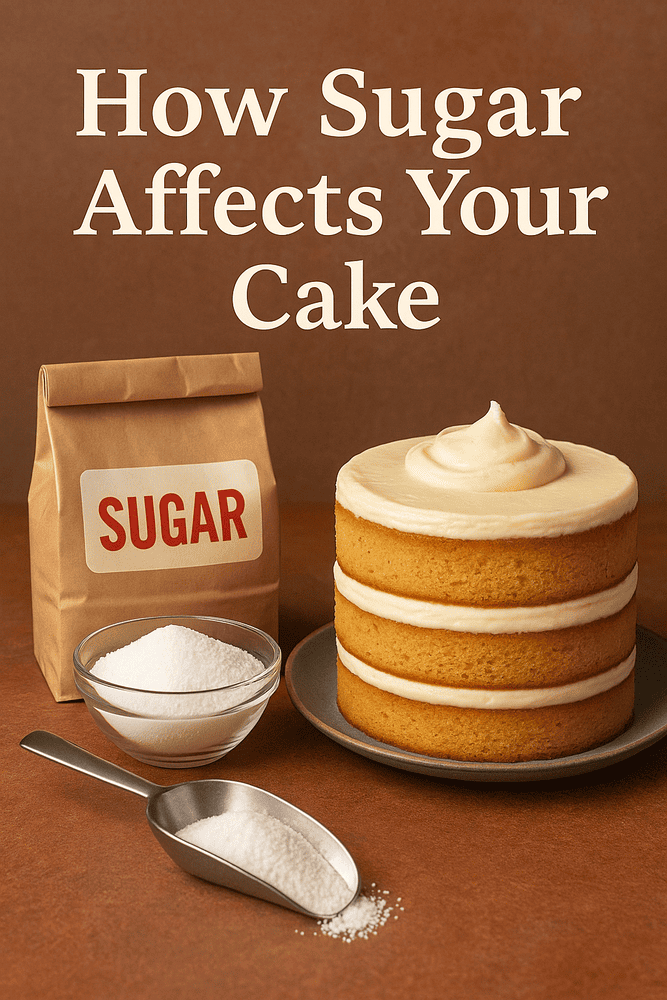Sugar may seem like a simple ingredient in baking, but its impact goes far beyond sweetness. In cake baking, sugar plays a vital role in everything from the cake’s structure to its moisture level and color. If you’ve ever had a cake that was too dry, too pale, or lacked flavor, it might not be the flour or butter—it might be the sugar.
In this article, we’ll explore the science of sugar in baking and show you how different types and amounts of sugar affect your cake’s outcome. By understanding sugar’s role, you’ll be able to troubleshoot recipes, adjust sweetness to your taste, and experiment with confidence.
First, let’s talk about the primary function most people know: sweetness. Sugar enhances the flavor of your cake, balances bitterness or acidity, and makes the overall taste more enjoyable. However, sugar doesn’t just add flavor—it also affects the way other ingredients behave. For example, sugar competes with flour for liquid in the batter. This slows gluten development, which results in a softer, more tender crumb. Less sugar often means a denser, firmer cake.
Sugar also contributes significantly to the cake’s texture. When you cream sugar with butter, the sugar crystals create tiny air pockets. These pockets help to trap air, which expands in the oven and gives the cake its lift. If you skip or shorten the creaming process, your cake might rise poorly or turn out dense. That’s why using the correct amount and texture of sugar matters, especially when making cakes from scratch.
Another key aspect is moisture retention. Sugar is hygroscopic, which means it attracts and holds water. This keeps your cake moist for longer. Cakes with insufficient sugar can dry out quickly, while those with a balanced sugar ratio stay soft and pleasant even days after baking. If you live in a dry climate or want your cake to last longer, sugar helps preserve freshness.
Sugar also influences browning. Through the Maillard reaction and caramelization, sugar helps develop a golden crust and deeper flavor during baking. This is why low-sugar cakes often look pale or feel undercooked even when they’re not. The more sugar in the batter, the more color and richness you get on the cake’s surface.
The type of sugar you use makes a big difference too. White granulated sugar is the most common and provides a neutral flavor with excellent creaming ability. Brown sugar, which contains molasses, adds moisture and a deeper, caramel-like taste. It’s ideal for chocolate cakes or spiced recipes. Powdered sugar is best for frostings, while superfine sugar dissolves quickly and is excellent in delicate cakes like sponge or chiffon.
There’s also liquid sugar—like honey, maple syrup, or agave—which adds not only sweetness but also liquid. When substituting liquid sugars for granulated sugar, you need to reduce other liquids in the recipe to maintain balance. Otherwise, the cake may become overly wet or fail to rise properly.
So how much sugar is too much? While sugar adds tenderness, too much can weaken the cake’s structure. A cake overloaded with sugar may collapse or become overly sticky. The general rule is to use equal parts sugar and flour by weight in standard cake recipes. Going beyond that requires precise adjustments to other ingredients, especially the eggs and flour.
Another role sugar plays is in stabilizing whipped eggs. In cakes that rely on beaten egg whites or whole eggs for leavening—such as angel food cake or genoise—sugar helps hold the foam. It strengthens the structure, allowing the cake to maintain its rise and stay airy. Without sugar, the foam may deflate before baking is complete.
Sugar also affects freezing and shelf life. If you plan to store your cake in the fridge or freezer, sugar helps maintain texture and flavor. Sugar reduces ice crystal formation and prevents the cake from becoming dry or bland after thawing.
Let’s quickly review how sugar influences key cake traits:
- Sweetness: Enhances flavor and balance
- Texture: Adds tenderness and soft crumb
- Volume: Helps create air pockets during creaming
- Moisture: Retains water, prolonging freshness
- Color: Contributes to browning and crust development
- Structure: Supports foam and overall balance
- Shelf life: Extends freshness during storage
Common mistakes include reducing sugar without adjusting other ingredients, using the wrong type of sugar for the recipe, or under-creaming. These can all result in poor rise, bland flavor, or dry texture.
Here are some practical tips:
- Always cream sugar with butter properly—3 to 5 minutes
- Use brown sugar when you want deeper flavor and extra moisture
- Don’t reduce sugar drastically without changing eggs or flour
- For low-sugar cakes, consider adding fruit purée to compensate for lost moisture
- Use superfine sugar for lighter cakes—it dissolves faster
- If using honey or syrup, reduce liquids by about ¼ cup per cup of liquid sugar
As you experiment more in baking, you’ll realize that sugar isn’t just about taste—it’s a powerful functional ingredient that shapes the final result. Understanding how it works gives you the freedom to tweak, substitute, and invent recipes that are both delicious and structurally sound.
If you’ve followed our previous articles on eggs, fluffiness, and basic tools, you now have a solid foundation. With this sugar knowledge, your cakes will not only taste better but also stay fresher and look more appealing. Up next, we’ll explore how different types of flour impact cake texture—so stay tuned for Article #7!
